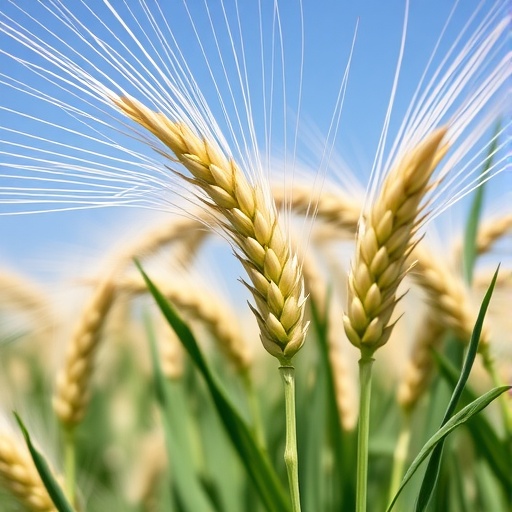In the relentless pursuit of meeting the escalating global demand for food, scientists are turning their focus toward the intricate architecture of wheat inflorescences—an area offering promising avenues for yield enhancement. The morphology of cereal crop inflorescences, shaped by millions of years of natural evolution coupled with human domestication, exhibits both conserved and divergent traits across species such as wheat, rice, maize, and sorghum. Central to yield, these architectural features dictate the grain number per spike, presenting a complex genetic and developmental framework ripe for scientific exploration.
Wheat, a staple crop sustaining a substantial proportion of the world’s population, typically features an unbranched, compact spike structure. This characteristic limits the total grain number per inflorescence when compared to other cereals like rice and sorghum, which possess branched panicles that facilitate a higher grain density. Researchers propose that re-engineering the wheat inflorescence towards a more branched phenotype holds immense potential to unlock latent yield capacity. However, this transformation is encumbered by biological trade-offs including reduced fertility and diminished grain weight observed in naturally occurring or mutant branched wheat varieties. The genetic complexity is further compounded by the typically recessive nature of the loci involved, complicating traditional breeding efforts aimed at stabilization and enhancement of these traits.
To navigate these challenges, scientific inquiry must delve deeply into the molecular underpinnings regulating spike branching in wheat. Identification and functional characterization of key genetic loci that modulate branching patterns will enable precise manipulation through advanced genetic engineering technologies. By strategically balancing the extent of branching with fertility and grain quality parameters, it is envisaged that novel wheat lines exhibiting moderated branching yet enhanced yield traits can be developed. This approach signifies a paradigm shift from conventional breeding towards a more tailored, genomic-guided crop improvement.
Concurrently, sustaining inflorescence meristem activity emerges as a fundamental mechanism to amplify spikelet number and ultimately grain yield. The inflorescence meristem, a specialized plant tissue comprising pluripotent stem cells, orchestrates the initiation and development of spikelets. Variations in meristematic activity influence how many lateral organs can form, with prolonged activity favoring an increase in spikelet count. Through targeted regulation of stem cell maintenance pathways, scientists are exploring ways to extend meristem longevity in wheat spikes. Such modulation promises the generation of denser spikes without deleterious effects on plant morphology or physiology, thereby boosting yield prospects.
Another critical determinant of grain yield resides in floret fertility, the successful development and seed setting of individual florets within the spikelets. Floret fertility is influenced by a complex interplay of genetic predispositions and environmental factors such as temperature, light, and nutrient availability. Enhancing our understanding of the genetic networks and physiological processes governing floret viability can lead to strategic interventions aimed at elevating grain set ratios. In doing so, the effective grain number per spike increases substantially, translating directly into yield improvement.
Complementing these biologically intrinsic factors, the efficiency of nutrient transport within the wheat spike plays a pivotal role in supporting grain development. The rachis, serving as the structural backbone of the spike, is a critical conduit for assimilates—including photosynthates and mineral nutrients—directed towards developing grains. Recent research emphasizes redesigning the source–sink–flow dynamics within the spike to optimize assimilate allocation. Upregulating the photosynthetic capacity of spike tissues and enhancing nutrient transport mechanisms along the rachis can substantially heighten floret fertility and grain filling rates. This metabolic optimization is poised to overcome current physiological bottlenecks limiting wheat productivity.
To holistically achieve these multifaceted objectives, the integration of multi-omics technologies offers an unprecedented lens into the complex biology of wheat inflorescence development. Genomic analyses provide the blueprint of genetic variants; transcriptomics, including single-cell resolution approaches, reveal gene expression dynamics in spatial and temporal contexts; metabolomics profiles the biochemical milieu influencing trait manifestation; and high-throughput phenomics captures detailed morphological and developmental phenotypes. By converging these datasets in comparative studies across cereal species, researchers can dissect conserved and unique regulatory modules controlling inflorescence traits.
The advent of artificial intelligence and deep learning methodologies further empowers this endeavor. AI-driven predictive modeling can synthesize multidimensional omics data to forecast phenotypic outcomes of specific genetic modifications or breeding strategies. This computational leverage facilitates the rational design of wheat inflorescence architectures optimized for maximum grain number and yield stability under diverse agroecological conditions. Genetic engineering tools, such as CRISPR-Cas systems, enable the precise editing of target loci identified through such integrative analyses, expediting the translation from discovery to real-world application.
Ultimately, these innovations collectively aim to transcend existing yield barriers that have constrained wheat production for decades. As global population growth and climate change exert mounting pressure on food systems, the re-engineering of wheat at the inflorescence level stands as a potent strategy to secure food availability. By systematically manipulating branching, meristem activity, floret fertility, and nutrient transport, the yield potential of wheat can be substantially augmented without compromising plant health or environmental sustainability.
This scientific roadmap underscores a new frontier in crop science, where the fusion of developmental biology, genetics, systems biology, and computational sciences converges to unlock the full promise of wheat yields. Through collaborative international efforts and continued technological innovation, the wheat inflorescence—once considered immutable—can be reshaped to meet the nutrition demands of the twenty-first century, heralding a breakthrough for food security worldwide.
Subject of Research: Wheat inflorescence architecture and genetic strategies for yield improvement
Article Title: Conceptual Framework for Inflorescence Architecture and Yield Improvement in Wheat
News Publication Date: Not specified
Web References: http://dx.doi.org/10.1016/j.scib.2025.10.032
Image Credits: ©Science China Press
Keywords: Wheat, Inflorescence Architecture, Crop Yield, Genetic Engineering, Meristem Activity, Floret Fertility, Nutrient Transport, Multi-omics, Food Security
Tags: agricultural biotechnology advancementsboosting wheat yield potentialbranched wheat phenotypescereal crop morphologycrop yield enhancement strategiesevolutionary traits in cereal cropsgenetic engineering in agricultureinflorescence traits and grain numbermeeting global food demandsustainable food productionwheat breeding challengeswheat inflorescence architecture





